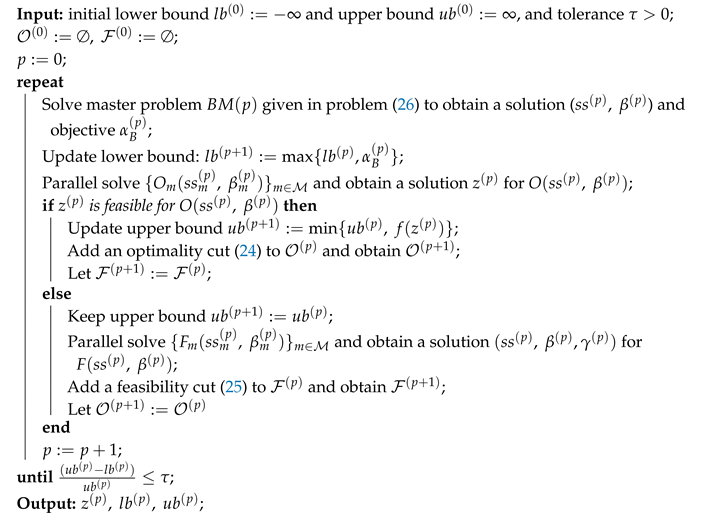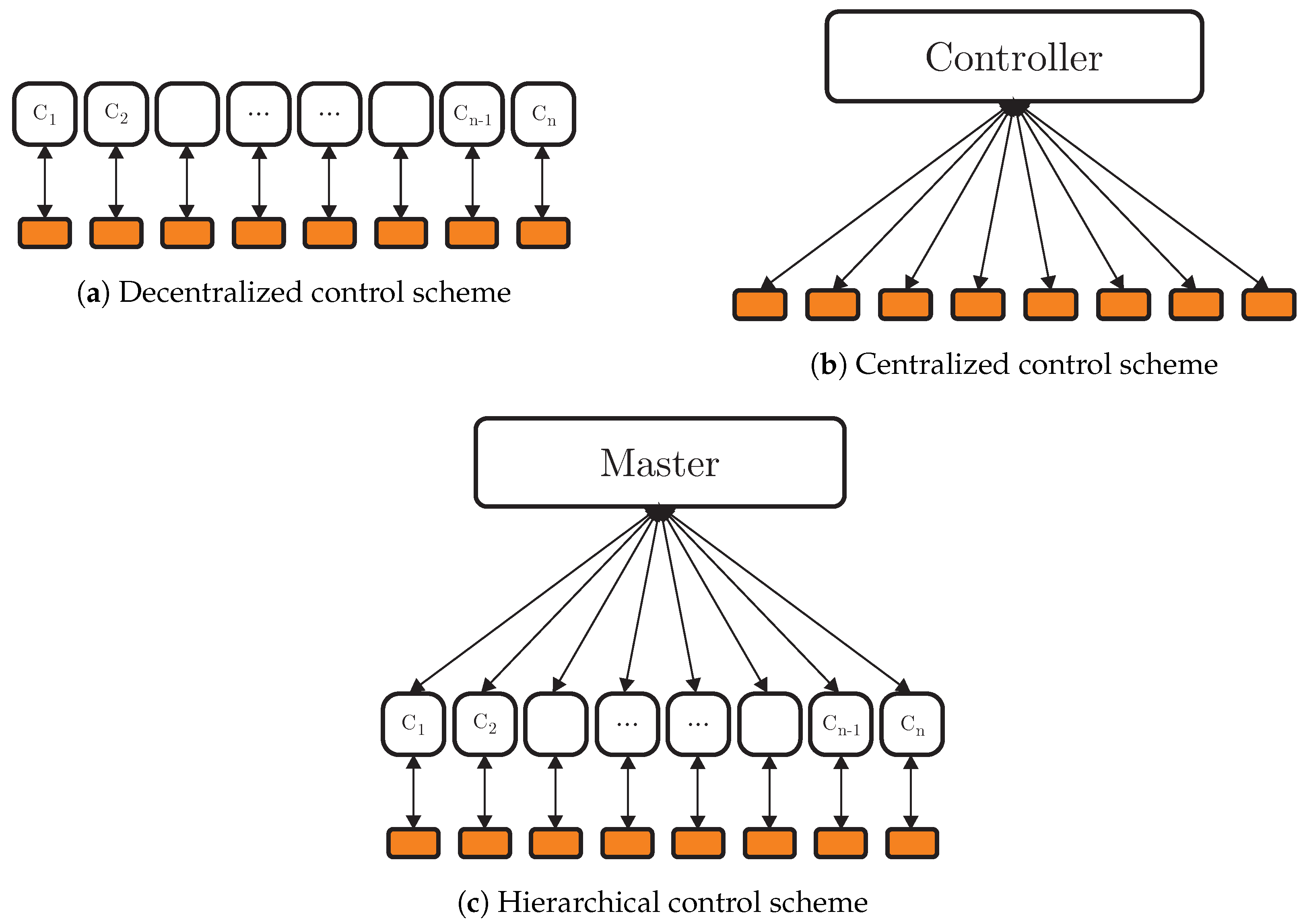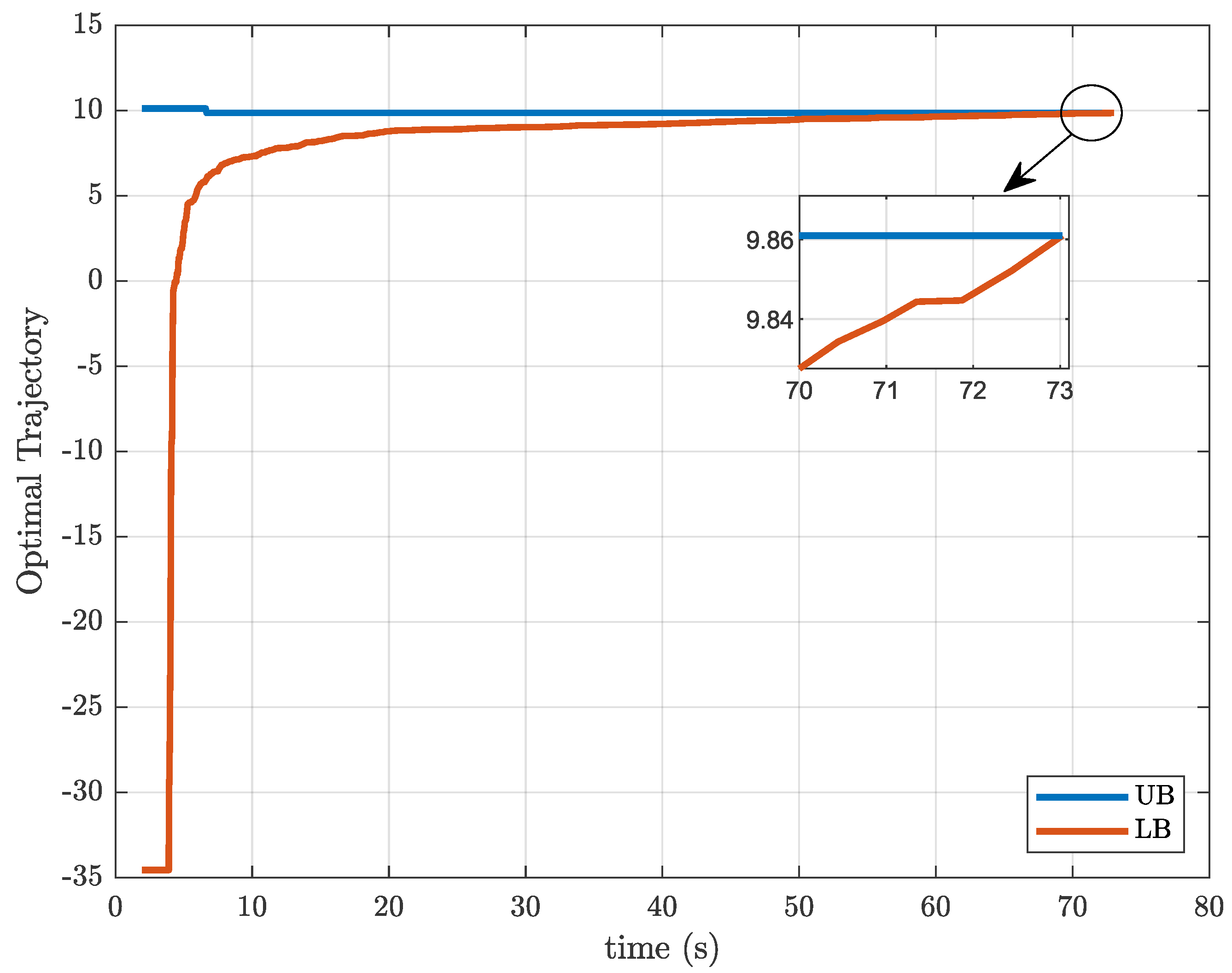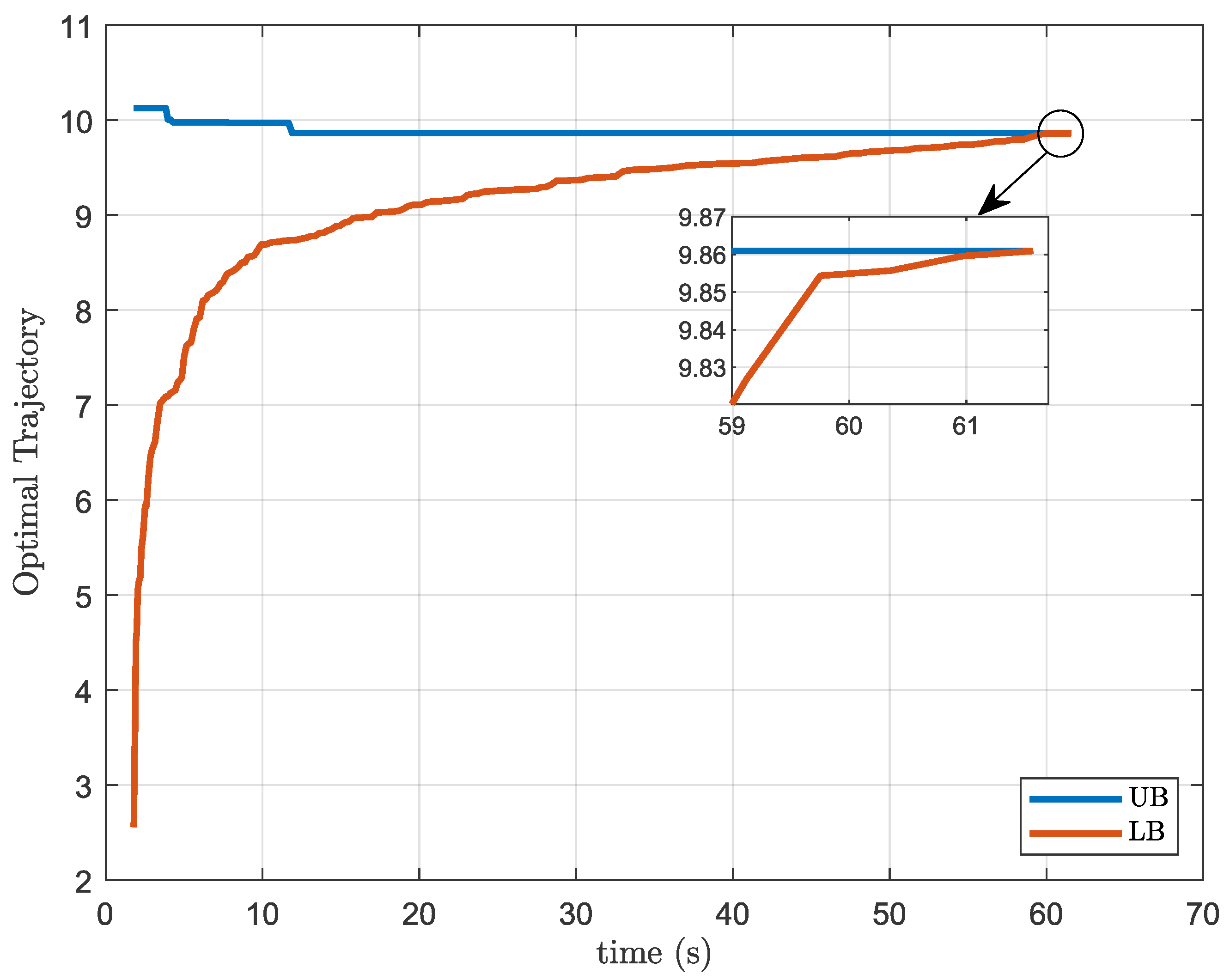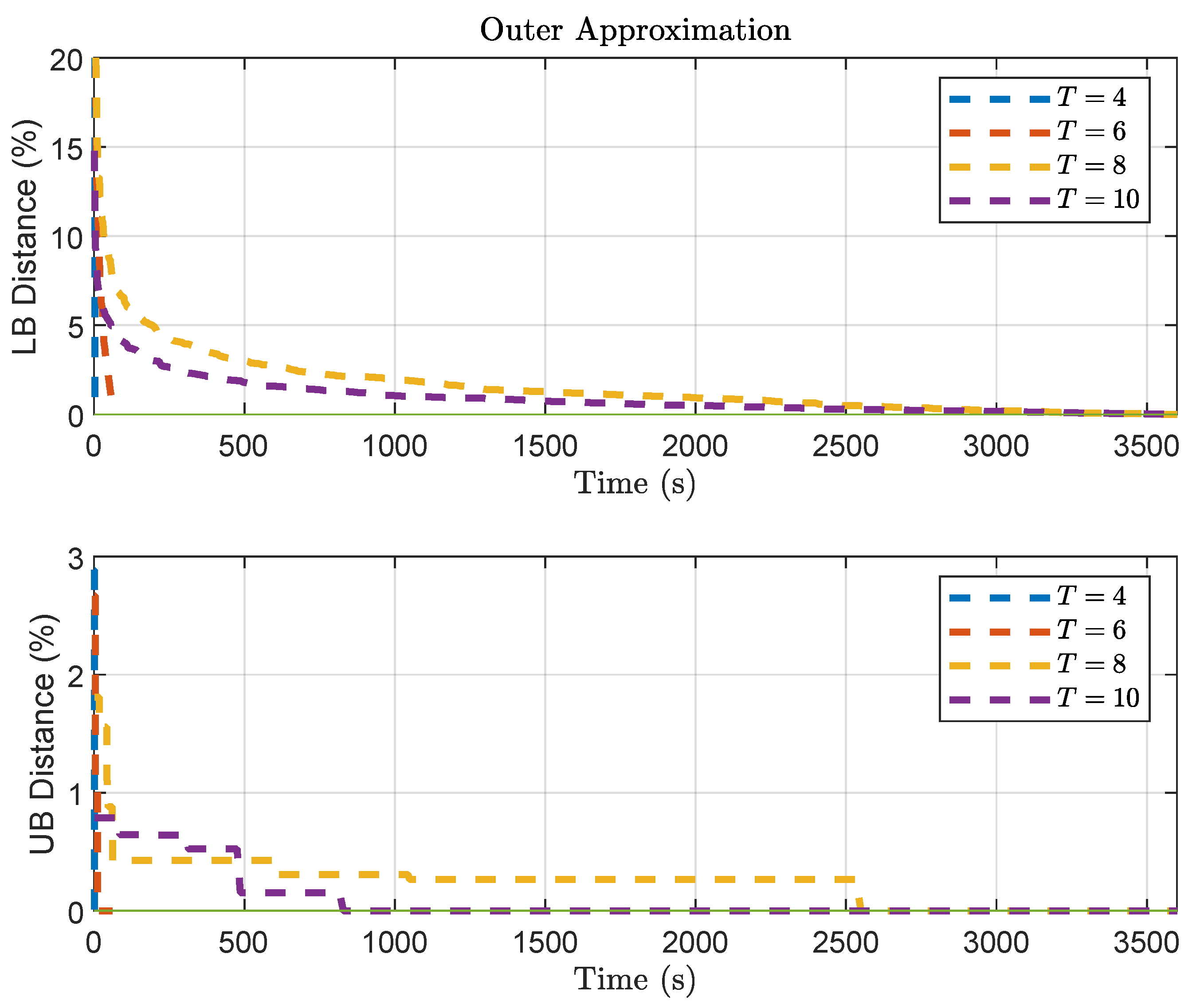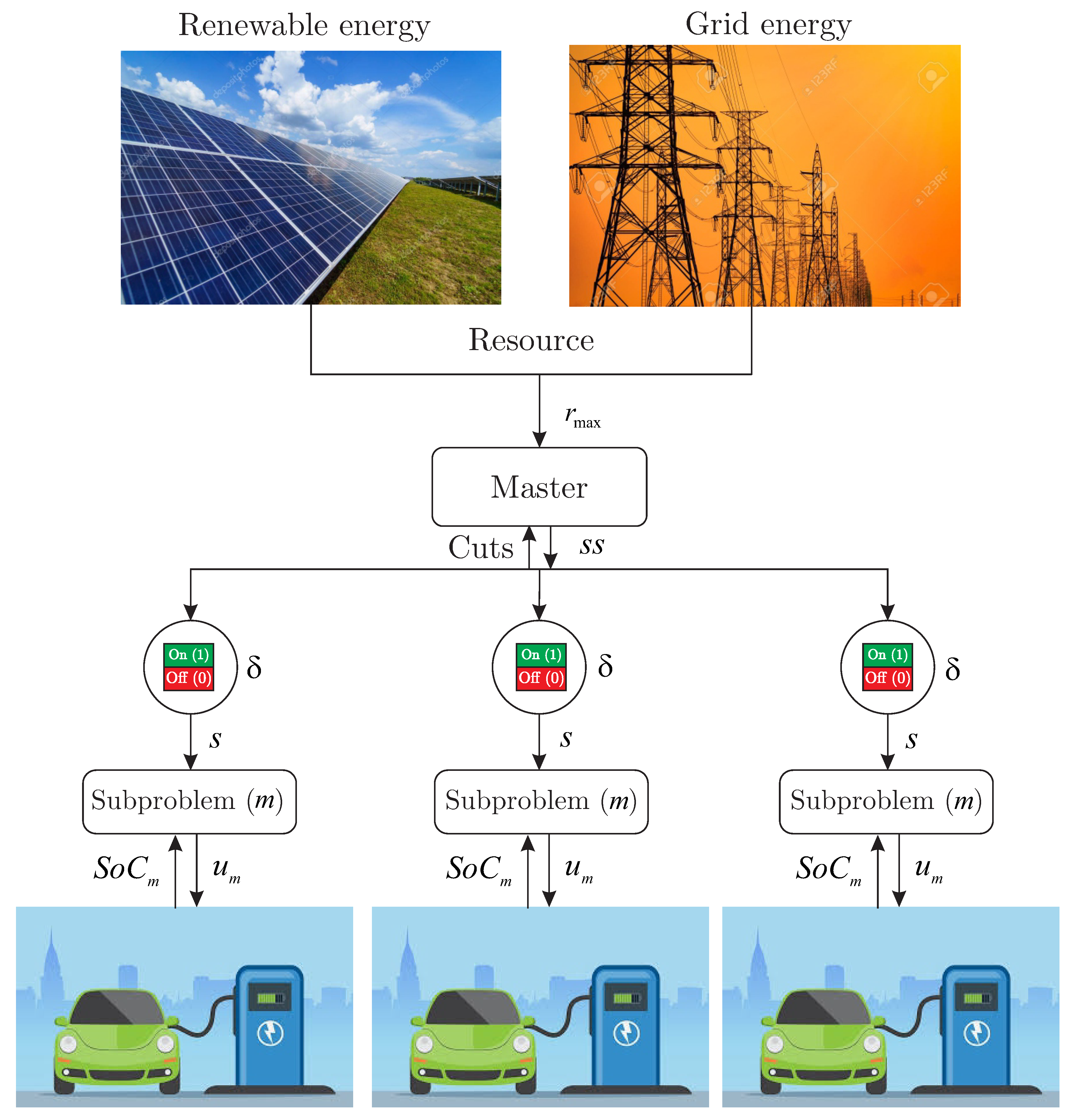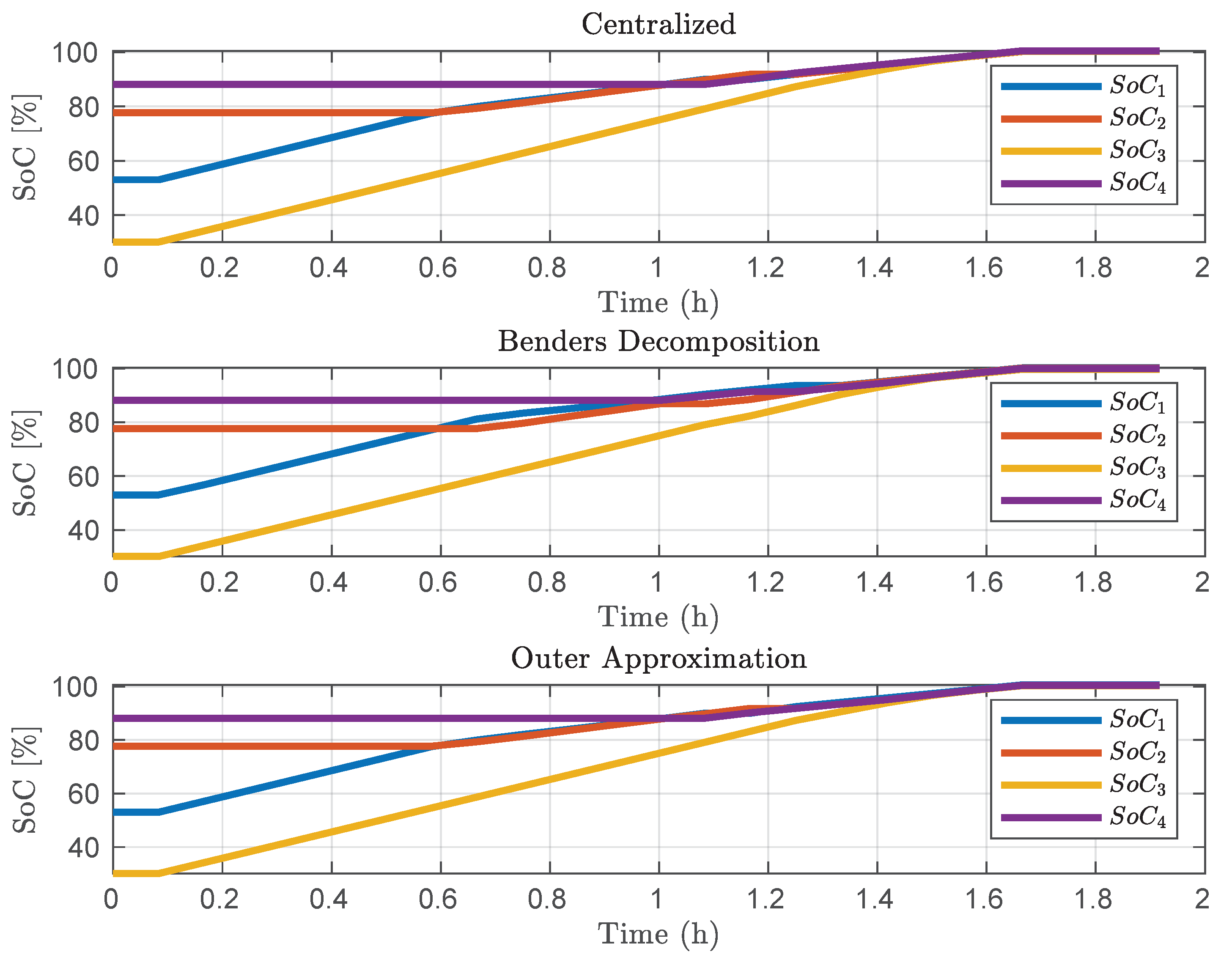1. Introduction
Several systems found in the industry and society emerge from the interconnection of dynamic subsystems that share limited resources [
1,
2]. Representative systems include stations for recharging electric vehicles, energy building management, and cooling fluid distribution in buildings, among others.
For instance, we can consider a building that has a Heating, Ventilation, and Air Conditioning (HVAC) as an example of a resource-constrained dynamic system. In this building, the cooling fluid is a limited resource shared among the rooms (subsystems), each with its energetic demand, depending on the number of users and the wall materials, among other factors. Another example appears in a water distribution system, which supplies the water demands of industries, houses, and commercial centers of a city. Thus, the water available in the water reservoir represents the limited resource at a specific time. Lastly, we can consider a charging station for electric vehicles (EVs), where each parked car generates an energy demand that can be supplied by the electric-power grid, photovoltaic panels, and even other batteries that are connected to the local grid. All of these systems presented depend on the distribution of limited resources (i.e., energy). Despite being interconnected systems, each subsystem (i.e., a vehicle with its battery being charged) does not need to know the state of another subsystem (i.e., the state-of-charge of another vehicle), only the amount of resources made available by the central system controller (master system) to the subsystem.
One of the control techniques typically applied to these interconnected systems is the Model Predictive Control (MPC), a control strategy widely used for energy applications, like microgrids [
3,
4] and photovoltaic applications [
5]. In this context, there are two classes of strategies that can be approached for controlling such systems, the centralized control [
6] and the decentralized control [
7]. Although decentralized control is fast and scalable, the lack of coordination between distributed units can lead to poor performance or render the operation infeasible.
Figure 1a illustrates the structure of this type of controller, where there is a controller for each system.
On the other hand, centralized control is capable of optimal performance, but the computational cost can become high, and the monolithic approach is less flexible.
Figure 1b presents a scheme for centralized control, where there is just one controller that communicates with all systems.
As an alternative, some approaches combine the characteristics of decentralized and centralized controls, with emphasis on decomposition strategies that enable hierarchical control, which can be seen in
Figure 1c, where there is a master problem that coordinates other controllers, so these controllers can be considered decoupled, having independent dynamics. Bilevel decomposition [
8], Lagrangean decomposition [
9], Benders decomposition [
10], and Outer Approximation [
11] are examples of such approaches.
In [
12], the authors presented a hierarchical decomposition approach for MPC of dynamic systems using Bilevel, Lagrangean, and Benders decompositions. The authors reported results from a numerical analysis of the decompositions and a simulated application to the energy management of a building, in which a limited source of chilled water is distributed among HVAC units. The benefit of hierarchical decompositions is organizational, as they allow the control system to be reconfigured locally and expanded with reduced coordination. The signals communicated between the master and the subsystems are relatively simple, consisting of resource allocations (from the master to the subsystems), and cuts and derivatives/sensitivities (from the subsystems to the master). The master does not need to have detailed information about the subproblems in such a structure, making this approach ideal for distributed and intelligent systems.
Despite this potential of parallel computation, hierarchical and distributed algorithms are often slower than their centralized counterparts. Thus, the main benefit of a hierarchical decomposition is not computational but rather organizational as it facilitates the expansion and reconfiguration of the control system. This feature stems from the simple coordination scheme and reduced information communication [
12]. In addition, it has already been shown in the literature that, by employing hierarchical decompositions, a reduction in computational time can be achieved by parallel computation, but not linearly as the number of cores increases [
13].
Benders decomposition and Outer Approximation, such as Bilevel optimization, allow us to harness the structure of the problem, in the same manner, using parallel computing. Under specific and general conditions on the problems, Benders decomposition and Outer Approximation ensure convergence to the optimal solution [
14]. These two decomposition strategies can be used to model activation variables, i.e., binary variables, to enable or disable the input of control signals into the system if necessary. In this sense, we extend the formulation previously presented in [
12] (which only considered continuous variables) to include activation variables (binary)—which are able to individually define which subsystems are on or off—using Benders Decomposition and Outer Approximation.
The use of activation variables is particularly interesting when dealing with limited energy resources problems and can delegate to the hierarchical MPC the decisions regarding the activation/deactivation of units. The use of activation/deactivation variables can bring about additional flexibility for the controller to maximize the control objective. That is, instead of keeping several subsystems at low levels, choose to turn off specific subsystems to prioritize the energy supplied to others. It is worth remarking that the formulation with activation/deactivation constraints is more general than its counterpart with only continuous variables.
The usefulness of the proposed decompositions is illustrated in an application to the distributed charging of electric vehicles with the use of activation variables (i.e., the possibility to enable/disable certain charging stations).
Everything considered, the main contribution of this paper is a hierarchical formulation for management of energy systems sharing limited resources, while considering the possibility to activate/deactivate units (subsystems) by means of Benders Decomposition and Outer Approximation. These formulations, tailored for MPC applications, bring about organizational flexibility to the central control unit (master problem), which does not need detailed information of the subsystems; only signals regarding the allocated resources and solutions are communicated. Such a flexibility allows for plug-and-play technology, thus becoming compatible with intelligent and distributed systems.
The remainder of this paper is organized as follows:
Section 2 presents the fundamental concepts for the development of the present research.
Section 3 presents the proposed decompositions for MPC of resource-constrained dynamic systems with activation constraints. Numeral experiments regarding the decompositions, and an application to battery charging stations, with activation constraints are presented in
Section 4. In conclusion,
Section 5 gives the final remarks.
3. Decompositions for MPC of Resource-Constrained Dynamic Systems with Activation Constraints
In this section, the formulation for the MPC of a class of resource-constrained dynamic systems is introduced, and, later, hierarchical decomposition strategies are formulated, namely Benders Decomposition and Outer Approximation. The hierarchical formulations presented here advance the previously presented in [
12] to consider activation/deactivation constraints. Using classic decomposition techniques in the literature, the two hierarchical formulations proposed here are especially useful for distributed and smart systems, so that the central control (master problem) does not need all the information of the subproblems to coordinate the energy distribution (i.e., the charging station for electric vehicles does not need to know specific information about a car, it only needs to manage the distribution of resources).
The MPC refers to an ample range of control methods that make explicit use of a process model to obtain the control signals by optimizing an objective function over a prediction horizon [
6]. At the current instant
k, the optimization produces an optimal control sequence, but only the first control signal is applied to the process. At instant
with the measurements updated, the process is repeated over the prediction horizon.
Let
be the set of subsystems,
be the set of the resources,
defines the control horizon, and
and
establish the minimum and maximum prediction horizon for the outputs. The MPC problem of interest is given by:
while, for all
being subject to:
and for
in which:
is the system state at time k and is the state prediction for time calculated with the information available until time k;
is the predicted output at time ;
is the desired output trajectory;
is the predicted control input and is the predicted control variation;
and are positive definite matrices that penalize the errors on trajectory tracking and control variation, respectively;
and are known values with the initial conditions;
, , , and are the system matrices of appropriate dimensions;
is the vector norm induced by a positive definite matrix Q;
, , , , , and are the imposed bounds on outputs, control signals and control variation, respectively;
are binary variables used to switch on and off the control signals of subsystem m;
is the amount of resource r available at time k and defines the rate of consumption by subsystem m.
3.1. Optimality and Feasibility Subproblems
Here, we begin by introducing the subproblem structure that is the same for both Benders Decomposition and Outer Approximation. The main distinction between BD and OA regards the master problem and cutting planes. Let be a vector with the amount of each resource allocated at each time for a subsystem m, and let be the vector with all resource allocations. Likewise, let ) be the vector with activation/deactivation variables for subsystem m over the control horizon, and .
For a feasible resource allocation
(i.e.,
for all
and
) and binary vector
with activation decisions, the optimality subproblem is given by
where:
- (i)
is a vector formed by all the variables of the subsystem m; is a vector formed by the resources available at all times and for all subsystems; and has all the subsystem variables;
- (ii)
and
are suitable matrices that define constraint (17i), and
and
representing constraint (
17k);
- (iii)
particularly so, for the problem of concern, is the identity matrix and is effectively since only the terms are needed in the constraint; and
- (iv)
the vector functions and represent the equalities (17b)–(17f) and inequalities (17g), (17h), respectively.
Notice that
induces an upper bound for a feasible
, meaning one vector
that satisfies the constraints (
17k) and one vector
that satisfies the constraints (17i), which renders problem
feasible. Clearly,
can be computed in parallel as follows:
for which
For an infeasible resource allocation and combination of binary variables,
, the following feasibility subproblem is to be solved:
with
being a vector of suitable dimension and
a nonnegative scalar. The optimal
can be obtained by solving an auxiliary subproblem only for the infeasible
. Let
. Then,
is solved as follows:
and, for all
, we solve the problem:
In fact, if is feasible for , then the corresponding will have an optimal value and the feasibility subproblem does not have to be solved.
3.2. Master Problem of the Benders Decomposition
At iteration
p of the Benders algorithm, let
be the resource allocation vector,
the vector of binary variables, and assume that
is feasible. Let
and
be the Lagrange multipliers associated with the resource constraint (20d) and the activation constraint (20e), respectively, at the optimal solution
. Then, the following optimality cut can be introduced to the Benders master problem:
with
being the lower bound of the overall objective of
P given by Equation (17). Due to the complementarity conditions, the local constraints (20b) and (20c) do not play a part in the cutting plane. The decision space of the Benders master problem consists of the vector
, with resource allocation and binary decisions, and the lower bound
.
However, if
is an infeasible vector at iteration
p, then let
be the subset of subproblems
m such that
. Solving
renders the following feasibility cut:
where the Lagrange multipliers
,
, and
are associated with the constraints (23c), (23d), and (23e), respectively.
At iteration
p, an optimality cut is obtained by successfully solving
, or else a feasibility cut by solving
. Let
and
be the indices of the iterations for which an optimality and feasibility cut was produced, respectively. Then, the Benders master problem at iteration
p can be stated as follows:
Algorithm 1 formalizes the Benders decomposition. The algorithm does not require a feasible starting point, since it can produce a feasible solution if one exists with the aid of the feasibility cuts.
| Algorithm 1: Benders Decomposition. |
![Energies 13 05744 i001 Energies 13 05744 i001]() |
3.3. Outer Approximation Master Problem
The problem of concern (17) is an MIQP with constraints being all affine and only the objective being nonlinear convex. By applying the OA algorithm, the MPC problem can be solved with a MILP algorithm (for the master) and a set of QPs (for the subproblems). To put it in another way, the constraint appearing in the master are the same constraints of the baseline problem (17), whereas the objective will be iteratively approximated with linear under estimators. This means that the OA algorithm will not produce infeasible iterates for the subproblems, and only optimality cuts will be generated.
At iteration
p, let
be the resource allocation vector,
the vector with binary variables, and assume that
is feasible. Then, using the optimal solution
of the optimality subproblem (18), it is possible to create the linear approximation for the convex objective
f,
in which
is the gradient for the objective function of subsystem
m. Since the equality
and inequality
constraints are all affine, there is no need to linearize the corresponding vector functions in the master problem. Then, the OA master problem at iteration
p can be stated as follows:
Algorithm 2 formalizes the Outer Approximation.
| Algorithm 2: Outer Approximation. |
![Energies 13 05744 i002 Energies 13 05744 i002]() |
4. Computational Analysis
In this section, the resource-constrained MPC formulation with the addition of activation/deactivation constraints on the control variables is validated. In this sense, the problem in its centralized form is solved for benchmark purposes; then, Outer Approximation and Benders Decomposition are applied to the baseline problem. In other words, the problem is reformulated into a hierarchical structure according to both decomposition strategies. This section is divided into two parts: (i) numerical experiments using synthetic instances, and (ii) an example problem of charging batteries to illustrate the use of the presented decompositions in a practical application.
4.1. Numerical Experiments
First, numerical analyses were performed, in synthetic instances, to give exemplification and insights into possibilities of solutions to these problems in a distributed fashion. The data and procedures followed to generate these problems are detailed in
Table 1.
Table 2 reports the size of the proposed problems. For a given number of subsystems and a stipulated horizon, the increase in the number of variables in the OA master problem and the subproblems is significant, compared to Benders decomposition. The number of variables is all added together in each column, and the column “Binary vars” contains the number of
variables in each problem. Notice that, given the generality of the formulation presented here, the numerical results given varying numbers of subsystems and prediction horizons are analogous to, for example, increasing the number of electric vehicles in a charging station or the number of HVACs in a building. In addition, the difficulty of the optimization problem increases with the number of binary variables.
Table 1.
Problem data related to
Table 3.
Table 1.
Problem data related to
Table 3.
| M | T | Seed | | | | |
|---|
| 4 | | 2 | | | | 2 |
| 8 | | 2 | | | | 2 |
| 10 | | 2 | | | | 2 |
| 20 | | 2 | | | | 2 |
The Julia Programming Language [
39] was used for being a new approach to numerical computing. Julia is an open-source language developed at the Massachusetts Institute of Technology (MIT) in 2012. Besides being a general-purpose language that can be used to write any application, many of its features are well-suited for numerical analysis and computational applications. Julia is dynamically typed, feels like a scripting language, and has good support for interactive use. Julia has been downloaded over 13 million times, and the Julia community has registered over 3000 Julia packages for community use. These include various mathematical libraries, data manipulation tools, and packages for general-purpose computing.
The algorithm was implemented using the modeling language for mathematical programming, JuMP [
40], which offers a high-level interface with solvers like IPOPT [
41], Gurobi, Artelys KNITRO, IBM CPLEX, and many others, for solving optimization problems.
The numerical experiments were performed in a computer with an Intel® Xeon™ CPU E5-2665 (2.40 GHz and 20 MB of cache), with 8 cores and 16 threads, 40 GB of RAM, and in a Linux environment.
The Gurobi solver, version 9.0.1, was used with a tolerance of
for the master and subproblems of both decomposition strategies, Benders and Outer Approximation. The relative gap between LB and UB was set to
as defined below:
According to [
14], the Outer Approximation method yields a tighter lower bound than the one produced by the master problem of Benders Decomposition. However, in our experiments, the tighter bounding procedures did not slow down the OA algorithm, which converged faster than the Benders decomposition.
For problems that the algorithms did not reach the tolerance defined by the relative gap, the Outer Approximation method was closer to the tolerance than the Benders decomposition when the CPU limit was reached, after 3600 s of computation—this behavior confirms the assumption that the OA algorithm produces tighter bounds in comparison to the Benders decomposition.
Suppose one compares the problem’s size, the number of binary variables in
Table 2, and the solution times in
Table 3. In that case, it can be noticed that the number of binary variables makes the solution of the problems more challenging.
Table 2.
Number of variables of synthetic problems with binary variables, for analysis of decomposition strategies. Column “MP” stands for the number of variables in the master problem, “Binary vars” corresponds to the binary variables of the master problem, and “SP” is the number of variables in the subproblem.
Table 2.
Number of variables of synthetic problems with binary variables, for analysis of decomposition strategies. Column “MP” stands for the number of variables in the master problem, “Binary vars” corresponds to the binary variables of the master problem, and “SP” is the number of variables in the subproblem.
| | | Outer Approximation | Benders Decomposition |
|---|
| M | T | MP | Binary Vars | SP | MP | Binary Vars | SP |
|---|
| 4 | 4 | 109 | 12 | 96 | 13 | 12 | 96 |
| 6 | 173 | 20 | 152 | 21 | 20 | 152 |
| 8 | 237 | 28 | 208 | 29 | 28 | 208 |
| 10 | 301 | 36 | 264 | 37 | 36 | 264 |
| 8 | 4 | 217 | 24 | 192 | 25 | 24 | 192 |
| 6 | 345 | 40 | 304 | 41 | 40 | 304 |
| 8 | 473 | 56 | 416 | 57 | 56 | 416 |
| 10 | 601 | 72 | 528 | 73 | 72 | 528 |
| 10 | 4 | 271 | 30 | 240 | 31 | 30 | 240 |
| 6 | 431 | 50 | 380 | 51 | 50 | 380 |
| 8 | 591 | 70 | 520 | 71 | 70 | 520 |
| 10 | 751 | 90 | 660 | 91 | 90 | 660 |
| 20 | 4 | 541 | 60 | 480 | 61 | 60 | 480 |
| 6 | 861 | 100 | 760 | 101 | 100 | 760 |
| 8 | 1181 | 140 | 1040 | 141 | 140 | 1040 |
| 10 | 1501 | 180 | 1320 | 181 | 180 | 1320 |
Table 3.
Computational analysis of the Outer Approximation and Benders decomposition.
Table 3.
Computational analysis of the Outer Approximation and Benders decomposition.
| | | | Outer Approximation | Benders Decomposition |
|---|
| M | T | f * | f | CPU(s) | GAP(%) | f | CPU(s) | GAP(%) |
|---|
| 4 | 4 | | | | 0 | | | 0 |
| 6 | | | | 0 | | | 0 |
| 8 | | | | 0 | | | 0 |
| 10 | | | | | | | |
| 8 | 4 | | | | 0 | | | 0 |
| 6 | | | | 0 | | | 0 |
| 8 | | | 3600 | | | 3600 | |
| 10 | | | 3600 | | | 3600 | |
| 10 | 4 | | | | 0 | | | 0 |
| 6 | | | 3600 | | | 3600 | |
| 8 | | | 3600 | | | 3600 | |
| 10 | | | 3600 | | | 3600 | |
| 20 | 4 | | | | 0 | | | 0 |
| 6 | | | 3600 | | | 3600 | |
| 8 | | | 3600 | | | 3600 | |
| 10 | | | 3600 | | | 3600 | |
Figure 2 and
Figure 3 show the optimal trajectory of the upper bound
and lower bound
generated by decomposition strategies when they are applied to the MPC problem with resource and activation constraints, for the case with
subsystems and prediction and control horizon of length
. Again, it is possible to see that the Outer Approximation bounds are much closer and converge significantly faster than the Benders decomposition.
Another interesting aspect can be observed by analyzing the convergence of both methods for varying length
T of predictions horizons.
Figure 4 illustrates the slow convergence of the Benders Decomposition, especially regarding the lower bound.
Figure 5 illustrates the convergence of Outer Approximation, where slower convergence can also be noticed regarding the lower bound.
Overall, in a set of test problems, both decompositions were able to obtain nearly optimal and globally optimal solutions, with Outer Approximation having a better performance and achieving the global optimal faster than Benders Decomposition for the synthetic problems proposed. Benders decomposition had a lower performance with problems with more subsystems or higher horizons compared to Outer Approximation. However, the results show that the decomposition algorithms produce iterates converging to the same global optimum obtained by their centralized counterpart.
Finally, the results reported in the experiments show that both decomposition strategies can be effective. They allowed the baseline MPC problem to be decomposed into a set of subproblems, whereby the master handles the binary variables (for the activation of control signals) and resource allocations, whereas the subproblems consist of small quadratic programs. The decompositions enabled a distributed solution of the MPC problem to achieve nearly optimal solutions for a given small tolerance. In other words, both hierarchical decomposition formulations can be directly applied to energy management problems under limited resources. The next subsection illustrates the application of the framework to a battery charging problem in electric vehicles.
4.2. Batteries Charging with Activation Constraints
This subsection presents an example problem of charging batteries to illustrate the use of the presented decompositions with activation constraints. Consider an electric car charging station, where each car is represented by an independent system subproblem that reports to the central station master to allocate resources. For each vehicle, there is a state of charge (
) associated with its battery, which can be defined as in [
42]:
in which
refers to the current
applied at the instant
k which, depending on its sign, determines whether the battery is charging or discharging, which also influences the value of
which defines battery charging efficiency;
sets the battery charge capacity to
, and
varies within the
range (from depleted to fully charged). The structure of the battery charging station and the system behavior are illustrated in
Figure 6.
The MPC problem (17) with limited resource constraints can thus be employed in the management of battery charging, using the model given by Equation (
30). Problem
P, in order to demonstrate a practical application, can be recast as follows:
where:
is the state of charge prediction for time calculated with the information available until time k;
is the desired SoC trajectory;
is the predicted current to be applied to the battery for charging in [A] and is the predicted current variation;
is the battery charge capacity of vehicle m given in [Ah];
is the activation variable used for turning the subsystems on/off;
and are positive definite matrices that penalize the errors on trajectory tracking and control variation, respectively;
and are known values with the initial conditions;
In this work, only battery charge is considered, so the current signal is non-negative, and, therefore, the charge efficiency value (
) is considered constant for all vehicles. As shown in Equation (31b), the system output
is the value of the state
. Therefore, we assume that the state is observable; otherwise, it would be necessary to apply a state observer or Kalman filter [
43].
The objective of the problem defined in (31) is the charging of batteries, and, thus, by defining a reference so that all batteries have of , the reference tracking error and the control effort applied to the subsystems are minimized.
4.3. Application to a Sample Instance
Consider a battery charging problem with the following characteristics, , that is, four vehicles, which have identical batteries with a charging capacity , and a charging efficiency . The sampling time chosen was [min], a prediction and control horizon of samples were considered, the maximum resource was for all instants and vehicles, and the current injection limits and its variations were defined as , , and .
The results of applying Benders Decomposition and Outer Approximation to the battery charging instance are shown in
Figure 7 regarding the control signals and in
Figure 8 regarding the state-of-charge of the batteries. It is possible to notice that all subsystems (vehicle batteries) were charged independently, using the distributed formulation and respecting the maximum available resource and the limits imposed on the defined variables.
The control actions favored the systems with less , causing them to recharge first. Only after reaching a higher , the control actions direct the available current to vehicles with a higher at the start of charging. The behavior induced by the controller keeps a balance between the resource available and the of all vehicles, thereby achieving the primal goal of charging all cars fully. The analysis showed that the electric vehicles can be recharged in a distributed fashion, approaching the optimal behavior that is achieved by a centralized counterpart.
The fact that the control actions show a similar behavior corroborates with the numerical results presented in
Section 4.1, where it can be seen that both formulations manage to converge to a global minimum within a predefined tolerance. Although the Benders Decomposition and Outer Approximation have slightly different behaviors along the charging path, it is expected that they reach close points due to the search for the global optimum. This similar behavior can also be noticed in
Figure 9, where it can be seen that the objective value of the cost function is equivalent between the approaches along the iterations of the MPC.
5. Conclusions
In this paper, we presented hierarchical decompositions for MPC of resource-constrained dynamic systems with activation constraints on the manipulated variables. First, the MPC problem was cast in a centralized form. Then, Outer Approximation and Benders Decomposition methods were developed for the baseline problem, which was reformulated into a hierarchical structure according to each decomposition strategy. Numerical experiments were performed, in synthetic instances, with the purpose of analysis and to give insights into the efficiency of such decompositions at solving the MPC problem in a distributed distributed fashion.
Considering a set of test problems, both decompositions could obtain nearly optimal and globally optimal solutions, with Outer Approximation achieving a better performance and reaching the global optimum faster than Benders Decomposition. Benders decomposition had a lower performance, particularly in problems with more subsystems or longer horizons, when compared to Outer Approximation. However, the results showed that decomposition strategies produce iterates that converge to the same global optimum achieved by their centralized counterpart.
An application to battery charging of electric vehicles, using activation constraints, was reported using these decompositions methods. The results show that the recharging of electric vehicles can be coordinated in a distributed fashion, approaching the optimal behavior achieved by a centralized controller. The problem’s hierarchical structure makes Benders Decomposition and Outer Approximation ideal for intelligent and distributed control, which are typical of smart systems.
As future work, regularization strategies can be considered for Benders decomposition to increase convergence speed. Multi-cuts can be designed for both decomposition strategies to improve the lower bounds produced by the master problem. In addition, on the application side, the proposed hierarchical frameworks can be applied to other energy systems, possibly considering real data.
